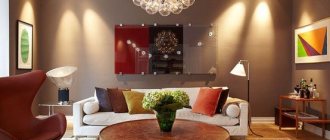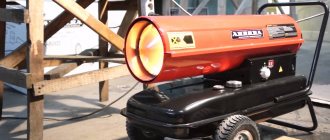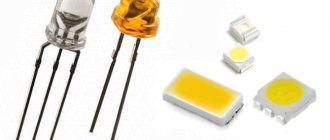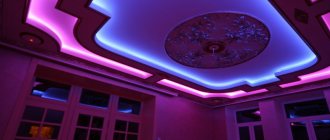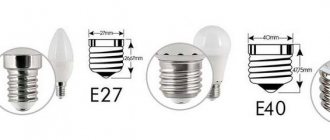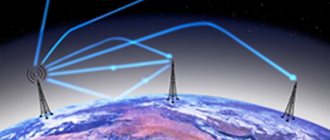Spotlights are a universal means of outdoor lighting. Used for lighting areas, landscapes, facades and security systems. These are targeted directional LED lights that project a beam of light onto a specific area, surface or object.
Spotlights are also the main element of indoor lighting. However, in the lighting industry, they typically refer to weatherproof outdoor luminaires that provide area lighting, ambient lighting, accent lighting, or task lighting.
Not only are they designed to project a wide spectrum of light, but they can also emit a narrow beam of light for spot or long-distance lighting. Thus, a floodlight can be defined as a directional outdoor light that is designed to provide controlled illumination within a desired range.
Useful articles:
DIY LED lamp, design, assembly diagram
Lighting for video shooting, types, practical tips
All articles
Sources of light
In the past, high-intensity discharge (HID) lamps, particularly high-pressure sodium (HPS) and high-pressure metal halide (MH) lamps, were the primary light sources for floodlights. However, the use of these gas discharge lamps is associated with many negative factors.
HPS can achieve relatively high source efficiencies (70–140 lm/W), but the light produced by this technology can significantly distort human perception of color. Consequently, HPS lamps have very limited application scenarios. Typically used in lighting applications where color perception has minimal impact on the intended use.
The history of artificial lighting is one of continuous development, marked by a number of important innovations. The latest innovation in lighting is semiconductor-based LED technology. LEDs overcome many of the disadvantages of HID lighting and enable floodlights to provide exceptional ROI.
Advantages of LED floodlights
Currently available LEDs have an efficiency of about 200 Lm/W. The directional nature of LEDs allows up to 95% of the light emitted by LEDs to be used.
High energy efficiency results in low operating costs and a short payback period. The long life cycle of a properly designed system and minimal maintenance requirements over the life of the product further reduce the overall cost of investment.
Distributing light evenly across a surface or area is critical in lighting design. With HID systems, most of the illuminance falls directly under the fixture, creating a hot spot of excessive brightness.
The benefits of LED floodlighting also include its exceptional spectral characteristics. The most cost-effective LEDs have a color rendering index in the 70–80 range, which is a significant improvement over HID light sources. This level of color quality is good enough to satisfy the vast majority of outdoor color rendering requirements.
Unlike the restrictive dimming capabilities of HIDs, LEDs allow lumen output to be adjusted to any desired level as long as they are equipped with a compatible driver that can perform dimming control. The ability to instantly respond to changes in power consumption allows for very dynamic control of LED floodlights.
Types of spotlights by type of light source
The type of light source is of fundamental importance when choosing a particular floodlight model. The following options are available: halogen, sodium and metal halide lamps, as well as LEDs. Each option has its own advantages and disadvantages, which determine the scope of application of floodlights of one type or another.
An undoubted advantage of a halogen spotlight can be considered excellent color rendition, close to sunlight. Devices of this type allow you to create diffuse, soft, shadowless or directional spot lighting. They are used to illuminate squares, large billboards, end walls of buildings, shopping and exhibition halls, as well as decorative lighting of bridges. The luminous efficiency of halogen spotlights is 16-20 lm/W. The lamp life reaches 2000 hours.
Types of LEDs in LED spotlights
LED floodlights use chips. These are bare LEDs that need to be packaged before they can be used as light sources. LED packaging provides thermal conductivity, electrical connection, mechanical support, and environmental protection for semiconductor diodes. While LEDs that emit a monochromatic color such as red, green or blue are often included in LED floodlights to produce an extended spectrum of precisely controlled light for landscape or architectural lighting. The vast majority of LED floodlights are designed to produce white light.
The package in which the LED chip is assembled must also provide wavelength conversion (partial conversion of short-wave blue light). As well as color mixing (blue light with downconverted light to produce the desired white light).
There are many options for packaging design and packaging materials. Ultimately, the optical, thermal and electrical performance of different LED package designs and LED packages from different manufacturers can vary greatly. However, the cost of LED packages can often outweigh the performance and ROI of the light source.
SMD LEDs (medium power)
They are cases with plastic pins for microcircuits that offer a very competitive price and high light output. Unfortunately, their benefits are compromised in outdoor environments and in high-power LED systems. High efficiency and low packaging costs for medium power LEDs are achieved through the use of highly reflective plastic and lead frame. The initial efficiency of these LEDs looks very attractive. However, at high operating temperatures, medium-power LEDs quickly lose luminous flux and change color. Thermal degradation is not the only reason these plastic packaging fails.
High Power LEDs
They provide excellent luminous flux retention and high packaging reliability, which justifies their high cost. The fundamental packaging philosophy of high power LED enclosures is to provide a robust platform that can withstand high thermal, electrical and environmental loads.
Eliminating thermally unstable plastic housings, corroding lead frames, and kink-prone wires allows high-power LEDs to operate successfully in high-temperature and hostile environments. A ceramic substrate with metallized copper layers and thermal vias ensures that a large amount of heat is transferred from the semiconductor junction to the surrounding air through the system's thermal path. High power LEDs can operate at more than one amp and emit thousands of lumens over a lifespan significantly longer than average power LEDs.
COB (Chip-on-Board) LEDs
These are multi-chip LED packages in which a high-density array of diodes is bonded to a matrix or ceramic substrate. These high-power units can reduce the number of discrete components in a system. COB LEDs can be mounted directly to the heatsink or via a connector, further simplifying system design.
LED COB spotlights are preferred for accent lighting applications where the fixture must provide a focused beam of evenly distributed light. Removing the intermediate substrate allows the LED chips to effectively dissipate heat through the circuit board or ceramic substrate. However, the electrical path to the individual LED chips in COB packages is created by connecting wires. This makes COB LEDs less tolerant of electrical surges than high power LEDs.
Criteria for selecting floodlights
The choice of a spotlight should be based primarily on the task. For example, there is no point in overpaying for the most powerful floodlight available if you need to illuminate the entrance to your house. There is enough brightness here to avoid tripping and taking your keys out of your purse, and a low-set bright lamp will only blind you. On the contrary, if the device is tasked with working in such a way that a person can read or work with small parts without stress, then a more powerful spotlight will be needed.
Voltage
Most spotlights are powered from a 220 V network, but gas-discharge lamps can only be started through a choke, halogen lamps require step-down transformers, and LEDs operate from a network driver designed for direct connection to a 220 V network. In some cases, the driver is not included in the kit to power the LED you will have to buy a 12 or 18 volt rectifier. As a rule, all additional elements of the circuit are placed in the housing of the street lamp and externally a device operating from a 220 or 12 volt network cannot be distinguished, so information about the type of power supply must be clarified.
Network driver with LED chip in disassembled device.
LED elements with a Chinese driver, where a diode bridge plays the role of a current rectifier, sometimes begin to blink or burn out when the network surges in the range of 200–250 V. The most unpretentious in this regard are halogens, although a high-quality driver with a stabilizer ensures LED operation even in the extreme range of 60–300 V.
Power
Traditionally, the main indicator of efficiency is the power of the matrix - the level of its energy consumption, measured in watts. The level of light output depends to some extent on the power. That is, the more powerful, the brighter and further the device shines. Traditionally, it is by power that the distance and area that a spotlight can illuminate is calculated.
| Lamp models | Power, W | Suspension height, m | Light spot height, m | Light spot length, m |
| LED 30 | 30 | 4-5 | 8-10 | 14-17 |
| LED 50 | 50 | 6-8 | 12-16 | 21-28 |
| LED 100 | 100 | 10-12 | 20-24 | 35-42 |
LED spotlight power calculation table.
To illuminate an area of 25 m2 from a height of a five-meter lamppost, an LED spotlight with a power of 35–40 W is sufficient, but it is worth considering that the light output of different LED elements with the same energy consumption varies greatly and these figures are subjective.
Types of LEDs
For powerful devices, two types of LED lamps are used:
- SMD matrices - consist of a group of LEDs of the same power, summed to achieve the desired level of light output. The disadvantage of the solution is that if one of the bulbs burns out, then the entire matrix fails, and soldering the jumper leads to an increase in the load on the remaining LED lamps. As a result, they burn out exponentially.
Appearance of the SMD matrix. - COB - cluster LEDs, which are a solid crystal. Compared to SMD they provide a more uniform light flow. The system is not without its shortcomings. Firstly, such lamps heat up more and require a powerful heat sink. Secondly, their cost is 20–30% higher than that of SMD.
COB type diodes.
Cluster LED elements are not widely used due to cost and the vast majority of lighting devices operate on matrix lamps.
Scattering angle
The light beam is distributed unevenly. The further its angle deviates to the side, the weaker it is.
Using the example of two lamps of the same power, you can see that the width of the central spot and the side illumination are different. In street lamps this parameter is not adjustable, since it is initially set by the shape of the reflector. Conventionally, according to the scattering angle, spotlights are divided into:
- search engines — long-range flashlights with a concentrated beam of light and a minimum of side illumination. Used on watchtowers, Open Air entertainment shows, and stage lighting;
- aspic - with uniform, wide-angle light required in most outdoor lighting applications.
IP protection class
Street lamps require protection from external physical factors with a degree of at least IP54. The first number means dust protection, the second - moisture protection . The maximum degree of IP68 implies complete sealing of the structure with the ability to immerse it under water for more than 1 hour.
Table of degrees of dust and moisture protection of devices.
Light flow
The main parameter that reflects the actual efficiency of the LED chip and is measured in lumens. However, for lighting calculations for a certain quadrature, a parameter such as lux is used - this is the amount of light energy in a certain area.
An area of 10 m2 with a 1000 lumen LED will be illuminated with an efficiency of 100 lux from a distance of 1 m.
From five meters this parameter will be reduced to 20 lux, which is quite enough to see where to go, but not enough for precise work. Complete calculation formulas are quite complex and special programs are used for this purpose, but approximate figures are presented in the lighting table for road lighting.
Road lighting table.
You can find out how much lux a particular sample produces only experimentally, using a lux meter. This is done at night, when the device is installed at a given height and the light is directed to a lux meter located in the center of the light spot.
Places for using floodlights
Lighting of areas and zones
Floodlights can be used as lighting fixtures to illuminate large geometric areas such as roadway interchanges, parking lots, car showrooms, airport aprons, rest areas, parks, warehouse areas, freight terminals and toll plazas.
Although floodlights may not be ideal for pedestrian and urban lighting due to potential problems with light dispersion and glare, these fixtures have been used as the workhorses of high-mast lighting systems. High mast lighting systems are typically installed in facilities not confined to photosensitive areas, such as apartment complexes, hotels and hospitals.
Floodlights can be aimed in any direction from the high mast frame to ensure that the most intense beams can be directed exactly where needed. Tall mast systems often need to be placed around the perimeter or some distance from the target area to minimize interference or conflict with the area.
Lighting of sports facilities
Floodlights are used to uniformly illuminate stadiums, arenas, sports fields and playgrounds or outdoor areas for sports such as archery, baseball, cycling, golf, motorsports, horse racing, football, tennis, skating, cricket, etc. .d.
Since there is usually no structure to mount ceiling lights and no surface to redirect the light bouncing off the playground, the only type of fixtures that can be used for outdoor sports lighting are direct beam floodlights. Sports lighting must be specifically designed taking into account proper illuminance values, uniformity coefficients, light distribution, mounting height, orientation and location.
Landscape lighting
Spotlights are essential for creating drama, beauty, depth, dimension, texture, space and focal points in a landscape scene. They can be used to highlight details of complex landscapes, such as monuments, sculptures, fountains or other architectural elements. "Softscape" lighting for trees, shrubs and other plants that illuminate a building or area is mostly achieved with spotlights through wash lighting, up lighting, moonlight, spot lighting, silhouettes and shading. A wide range of light distributions and a rejuvenating combination of lighting methods offer virtually limitless possibilities for lighting effects.
Architectural lighting
The architectural features of a building or structure are a critical design element that can be emphasized to provide prestige, symbolism and recognition. Architectural spotlights can be used to “wash” even light, to pop out walls to highlight the textured beauty of a vertical surface, and to accent lighting areas of visual drama and differentiation. Spotlights can be used to enhance interior charm and create an exciting three-dimensional impression.
Security Lighting
Floodlights are often installed around the perimeter of residential, commercial, industrial and institutional buildings or structures to provide safe lighting. Lighting can act as a deterrent to criminal activity and create the impression of a relatively safe environment. Perimeter lighting from wide-beam floodlights can improve surveillance, deter intruders, and facilitate the proper use of other security devices such as security cameras and video intercoms.
Industrial outdoor lighting
Lighting of areas and work areas of industrial parks and open-air production facilities such as oil refineries, chemical plants, drilling rigs, tank farms, wastewater treatment plants and quarries is often complemented by floodlighting. Because these areas may contain high humidity, flammable vapors, corrosive atmospheres and hazardous materials. Industrial floodlights can be designed to meet these stringent conditions and are certified for use in hazardous locations classified according to hazardous area standards.
Mobile light towers
To illuminate places where there is no possibility of connecting to the network, mobile lighting towers are used. This is a trailer mounted lighting system designed for construction sites, road work, disaster response, outdoor events and other temporary public lighting. A set of floodlights is mounted on the head frame of a retractable mast, which is quickly and easily deployed using a manual or electric winch.
Billboard lighting
Advertisers are interested in ensuring that the advertising information they provide is available not only during daylight hours, but also during evening and night hours, which increases its commercial effect activity. Therefore, there is an urgent need to illuminate advertising objects at night.
Floodlights are used to spread light across a billboard from edge to edge and corner to corner, allowing the advertisement and display design to impress passersby at night. Thanks to special fastenings, it is possible to use lighting over the entire surface of the advertising product in a unique way.
Methods for classifying lighting fixtures
Depending on the purpose, it is convenient to use various features for classification.
Classification by place of application
Indoors:
Comparative table for the use of lighting fixtures indoors
| Lamps | Spotlights | Projectors |
|
|
|
We advise you to study How to arrange site lighting
Lighting devices of this type may be subject to additional requirements for maximum brightness of one element (indoors), dust protection (in industries), fire safety and water/dust protection (in mines).
In open spaces:
Comparative table for the use of lighting devices in open spaces
| Lamps | Spotlights |
|
|
In the classification, the name indicates the scope of application, which defines additional requirements. For example, for marine floodlights - increased moisture protection, for anti-aircraft floodlights - requirements for power and dispersion of the light beam, for illumination of architectural structures, the aesthetic component and fire safety are important.
In extreme environments:
Lamps and spotlights
- Under the water
- In space
This class of devices is characterized by a complex design and high price due to special requirements for resistance to environmental influences.
Classification according to environmental protection level
The international designation system (Ingress Protection) operates in terms of protection against the penetration of solid particles and water.
The first number indicates protection from dust, the second from moisture.
Table of symbols for protection against dust and moisture
| Dust protection | Moisture protection |
| 2 - no protection provided 3 - there is no protection from dust, but insulation is provided to prevent particles with a cross-section of more than two and a half mm from coming into contact with current-carrying elements. 4 - there is no protection from dust, but the insulation is designed to prevent contact with current-carrying elements by bodies with a cross-section of more than 1 mm 5 - current-carrying elements and lamps are protected from dust 6 - complete protection against dust getting into the lighting fixture | 0 - no protection 1 - digit not used 2 - protection from drops falling from above at an angle of 15 degrees to the vertical 3 - rain protection 4 - protection against drops and splashes from any direction 5 - protection against jets 6 - protection from waves (temporary ingress of large volumes of water) 7 - protection against immersion for a limited time and depth 8 - complete protection (tightness) |
For example, the IP20 marking, typical for household appliances, indicates the absence of any protection. Street lighting lamps usually comply with IP54 - protected from dust on live elements and from jets of water (rain).
Classification of lighting devices by design
- Built-in - installed in a prepared niche in the structure of a building or device;
- Tabletop - designed for installation on a table or other furniture without rigid fastening;
- Suspended - attached to the surface from below using structures more than 10 cm high;
- Ceiling - direct installation to the ceiling or using a unit less than 10 cm high;
- Cantilever - for example, Soviet-style street lighting lamps, the main feature is a displaced light center relative to the mounting point;
- Portable - wearable devices powered by a flexible cable or battery;
- Wall-mounted - attached to a vertical load-bearing surface;
- Crowning - used to illuminate open spaces.
By type of lamps used
One of the additional features for classifying lighting devices is the type of lamps used:
- incandescent,
- arc,
- halogen,
- luminescent,
- sodium,
- diode.
Due to the development of technology, this list is constantly expanding and divided into subclasses, and cannot be given in full, however, the main current types of light sources are given.
Spotlight design
Integrated spotlights
Similar to its HID predecessors, which are a stand-alone system. This type of LED fixture is designed to be used with a lighting engine with a system power typically less than 300W. The electrical system is housed together with the LED unit in a sealed die-cast aluminum housing.
Earlier generations of LED floodlights follow the form factor of HID systems and are typically bulky and clunky in appearance. Modern integrated LED spotlights, as a rule, have an organic design and laconic forms. The perfect integration of all elements into the structure ensures that these attractive luminaires have great aesthetic value.
Modular spotlights
Modular floodlighting systems offer a significant number of options and settings. The main building block of these LED fixtures is the modular LED motor, which includes all elements of the LED system except the power supply.
The modular architecture allows a variable number of light engines to be mounted on a bracket or mounted to a frame to provide the required lumen output and light distribution according to design specifications. LED drivers and other electrical components are usually attached to the back of the fixture. Waterproof drivers are either exposed outdoors or enclosed in a sealed power supply for an added layer of protection. The modular design provides benefits such as scalable light output, the ability to adjust the beam direction for each module, and ease of maintenance and replacement.
Optical floodlight system
Secondary optics, which form the radiation pattern of LEDs in floodlighting systems, can be divided into lenses, reflectors, and combinations thereof. Reflectors, made of either aluminum or coated plastic, control the light output from LEDs through specular reflection, semi-mirror reflection or diffuse reflection.
To achieve wide beams, a large reflector is usually used to cover the entire LED matrix. However, a system-wide reflector is not suitable for optical assemblies with a large light-emitting surface because a significant portion of the emitted light from the discrete LED array exits the reflector aperture without hitting the reflector surface.
Reflectors for LED floodlights typically have square or rectangular outlets to match the form factor of the fixture. The outlets of the reflector arrays can be round or square depending on the light distribution requirements. Reflective matrices can also be used to produce narrow beams.
In some cases, additional lenses such as convex, collimated or microprismatic lenses are built into custom molded reflector cavities to improve light output efficiency or maximize visual comfort. System-wide reflectors for LED floodlights typically have square or rectangular outlets to match the fixture's form factor.
Composite lenses, which integrate an array of lens elements on a common axis, have gained an advantage over optical reflectors in high-power LED floodlighting systems or in applications where beam control is critical. Total internal reflection optics are based on characteristics unique to LEDs and are capable of precise beam control and uniform light distribution with optical efficiency of up to 93%. A lens consisting of a refractive lens and a reflector combines the best optical characteristics of the reflector and the lens. A refractive lens located inside the reflector directs virtually every ray of light emitted by the LED and directs the rays onto the reflector, which directs them in a precisely controlled beam.
Other criteria for grouping luminaires by type
Separation of luminaires in accordance with the special requirements of GOSTs
In accordance with GOST, other types of lamps are also distinguished based on compliance with general criteria, which make it possible to assign the corresponding symbols to the lamp. Their meaning is deciphered in the table.
Types of lamps depending on security
All lamps pose a certain danger to the health of users, since they are current-carrying elements. The level of safety largely depends on the integrity of the devices themselves that create the lighting. Therefore, depending on the safety requirements for use, x is also classified according to the level of protection from external influences. For this purpose, special International Protection standards (abbreviated as “IP”) are used.
This system was developed taking into account the requirements for luminaires by GOST, international standards IEC 60529, as well as DIN 40050). IP codes describe the degree of protection from environmental factors, as well as the level of safety of the luminaire for the consumer.
We advise you to study What is a throttle
The luminaires are grouped according to a combination of 2 numbers (IP-XX). The 1st digit indicates the level of protection against the penetration of solid particles:
- the number 0 means that protection against the ingress of solid particles is not provided;
- 1 – there is a guarantee of protection against particles larger than 50 millimeters;
- 2 – protection against penetration of objects equal to or more than 12 millimeters is provided (middle finger);
- 3- Provides protection from objects whose diameter is greater than or equal to two and a half millimeters;
- .4 – the number indicates protection against penetration of objects with a diameter greater than or equal to one millimeter;
- number 5 indicates the presence of protection, which guarantees that objects whose diameter is equal to or exceeds the size of dust cannot enter the device;
- The number 6 confirms complete protection against microparticles (dust) getting into the device.
The second part encodes the levels of protection against water penetration:
- the number 0 indicates the absence of any protection from moisture penetration;
- number 1 indicates the presence of minimal protection from water drops that fall from above;
- number 2 indicates the presence of protection against water drops that fall on the device at an angle not exceeding 15˚;
- number 3 codes the presence of protection against drops that fall on the device at an angle of no more than 60˚;
- the number 4 indicates the presence of protection that prevents the penetration of liquid drops that fall at any angle;
- number 5 indicates existing protection against penetration of low-pressure water jets;
- number 6 codes the presence of protection against water penetration in the event of a high-pressure water jet hitting the lighting fixture;
- the number 7 means that the lighting device is protected from moisture when dropped into water at depths not exceeding a meter, and this protection is effective for thirty minutes;
- The number 8 codes lamps whose protection guarantees the complete impossibility of moisture entering when immersed in water to depths exceeding one meter.
Degree of protection (IP) of the floodlight
LED floodlights must be carefully sealed and sealed at all material entry and transition points to prevent the entry of moisture, corrosive gases, dust, pollutants and insects. Moisture absorption is one of the common failure mechanisms responsible for premature failures, lumen degradation, and color changes in LED packages. Silicone sealant has high moisture permeability and absorbs moisture in an atmosphere with high humidity. When exposed to extreme temperature cycles, the presence of moisture is known to be a major cause of delamination of silicone sealant. Moreover, corrosive gases can penetrate the silicone sealant and cause corrosion of the metals used in LED housings.
For outdoor floodlights, the protection level is IP65, IP66, IP67 or IP68. It is necessary to ensure high tightness of the entire luminaire housing, including the light engine and the driver/electrical compartment. However, the IP level may drop if the seal is repeatedly stressed due to pressure differentials within the housing. Pressure changes are mainly caused by periodic changes in outdoor temperature and are exacerbated by high housing temperatures of LED luminaires. Repeated expansion and contraction due to cyclical increases in positive and negative pressure within a sealed housing will eventually lead to seal failure.
To maintain the original IP rating, outdoor LED luminaires typically use a breathing membrane, which provides a strong barrier against liquid, dust, dirt, etc., allowing air to pass through the membrane to continuously equalize pressure.
Floor lamps for comfort and coziness
Floor lamps are used for zone lighting in rooms with various purposes. They decorate the interior, create special conditions of comfort and coziness, and are also products that allow you to implement various design lighting solutions. They are multifunctional light sources placed on a special leg (tripod) or stand. They have another name - floor lamp, which translated from French means torch.
Classification and benefits
Floor lamps are classified according to the following criteria:
- purpose (decorative, functional);
- model type (with an adjustable tripod and without height adjustment function, regular and with additional accessories);
- overall dimensions;
- material of manufacture (wooden, rattan, crystal, traditional, metal, Tiffany);
- lampshade shape (spherical, trapezoidal, conical, hemispherical, abstract, flower-shaped, etc.);
- type of lamp for lighting (incandescent, fluorescent, LED);
- number of lampshades (from 1 to 6 or more);
- number of legs (1 ÷ 3 or more);
- color;
- degrees of protection (regular, dust and waterproof).
Decorative floor light sources are part of the interior; they perform not only the function of local lighting of a certain area, but also an aesthetic one. The main purpose of functional lamps is to illuminate a workplace or recreation area.
The main advantages of floor-mounted light sources include:
- the ability to create the required level of illumination in a certain area;
- no need to perform special installation work for their installation;
- mobility.
Features of choosing floor light sources
Modern floor lamps are produced in a huge range by domestic and foreign manufacturers. Their diversity is amazing and surprising. LED floor lamps are the most economical in terms of electrical energy consumption. They differ in the material from which the lampshade or shade, as well as the stands, are made, and their shape can be very diverse. Choosing the right model for specific needs is quite difficult. Therefore, the tips below will help you decide on the type of light source:
you need to pay attention to the size of the room. In small rooms it is better to use classic (traditional) products
They are characterized by their large size, made of textiles, and located on a curved leg/legs. Lamps can be made in the form of a pole, vase, flower, with tripod-shaped tripods or even compositions, and can be equipped with USB ports and special lamps designed for reading. For large rooms, lamps with shades that emit light upwards and to the sides are suitable. Light sources up to 1m high will make the room taller; for reading, place a lamp with a small table or shelves of directional light; floor lamps are selected to match the interior style of the room in which it will be installed; the lampshade must be selected to match the color of the curtains, chair, sofa or blanket; the most popular colors of light sources are white, black, cream and gray; When installing the lamp in a damp or unheated room, you must pay attention to the degree of protection of the product. It must be at least IP Indicated in the passport data: for floor lamps that are not equipped with lamps, it is necessary to select the correct lamps in terms of power.
We advise you to study the rj 45 connector crimping tool
If you want a very beautiful lamp, pay attention to devices produced under the name Tiffany. They belong to lampshades made using special technology
The products resemble elements of stained glass, which reflects on the atmosphere of comfort in the room.
Floor reading lamp
Reading, knitting or working with gadgets under a lamp is a convenient relaxation option. For these purposes, floor lamps with accentuated diffused light are purchased. Such products are equipped with a table or shelves, chargers, and USB ports. The lamp is equipped with a lamp height adjustment function, which allows you to change and adapt the illumination depending on the characteristics of the person. Of course, the reading light should also be selected depending on this factor. Because poor-quality lighting will affect your vision and cause headaches.
Floor-mounted lamps will decorate the interior of any room and create a cozy and comfortable atmosphere for work, reading and craft-related activities. The main thing is to choose them wisely.
Lighting control
LED floodlights can be configured to implement multiple levels of control strategies to maximize energy savings, optimize light quality, or create pre-programmed light shows and dynamic effects.
LED drivers can be designed to provide dimming capabilities, allowing light levels to be controlled using pulse width modulation or continuous current reduction (using 0-10V, DALI or DMX controls). These devices can be programmed to interpret control signals from occupancy sensors, daylight harvesting photocells, electronic logic circuits, or remote controllers.
Modern control tools are usually systems for networked interactive control of luminaires as a whole, by zone or individually. They also use a wireless network, such as Bluetooth or ZigBee, to monitor performance and operating conditions.
Catalog of FOCUS lamps

